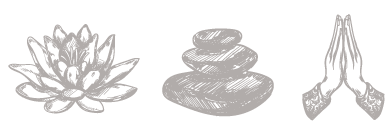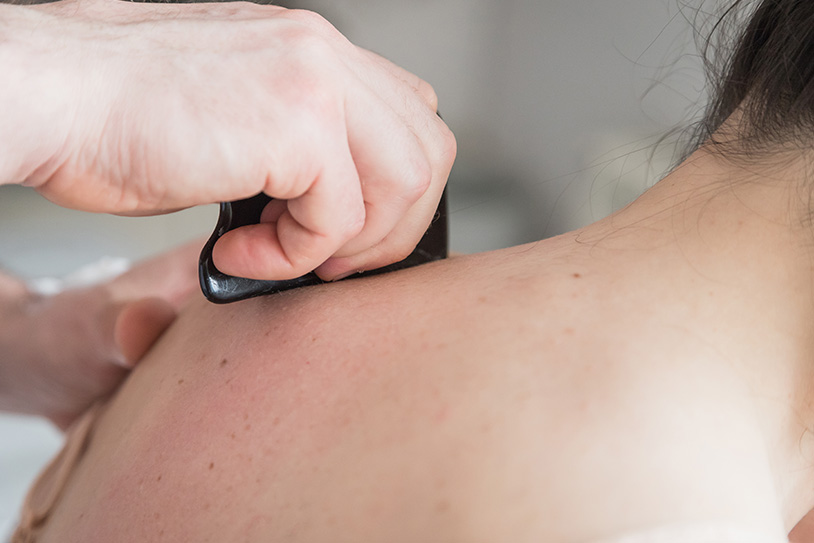What is Gua Sha?
Gua Sha is a traditional healing technique that involves scraping or rubbing the skin with a smooth-edged tool to relieve muscle tension, promote blood flow, and boost overall energy. It has been used for centuries in Chinese medicine to treat various health conditions. At Blue Root Health, Gua Sha is incorporated into holistic treatments to help manage pain, reduce inflammation, and promote deep relaxation. The practice can also be used to address conditions like migraines, neck stiffness, and chronic fatigue.
What does Gua Sha do?
Gua Sha works by stimulating the flow of blood, energy (also known as "Qi"), and lymphatic fluid throughout the body. The scraping motion helps release muscle tightness, reduce inflammation, and improve circulation. At Blue Root Health, we use Gua Sha to help with a variety of conditions, including chronic pain, muscle stiffness, tension headaches, and even skin health. The technique can also boost overall energy and promote a sense of well-being. Additionally, Gua Sha can help with detoxification by encouraging the removal of metabolic waste from the body.
Is Gua Sha Safe?
Gua Sha is a completely safe technique, but it is serious medicine. Knowing when to use it and what to expect from treatment is as important as good technique. People who live in chronic pain often erect emotional defenses to cope with it or can feel completely hopeless. Having that pain ‘touched’ and relieved can be unsettling, even shocking. It is good to be moderate in activity after treatment, even rest. I have always told my patients after treatment: no drugs, booze, sex, fasting, feasting or hard labor, including working out, for the rest of the day. In other words, mellow mode.
Where is Gua Sha applied?
Sha is raised primarily at the Yang surface of the body: the back, neck, shoulders, buttocks, and limbs. On occasion, Gua Sha is applied at the chest and abdomen.
How is Gua Sha applied?
The area to be Gua Sha-ed is lubricated with oil. The skin is then rubbed with a round-edged instrument in downward strokes. One area is stroked until the petechiae that surface are completely raised. If there is no Blood stasis the petechiae will not form and the skin will only turn pink.
What kind of instrument is used to Gua Sha?
A soup-spoon, a Jade Stone with rounded edges, or slice of water buffalo horn is used in Asia. I have found that a simple metal cap with a rounded lip works best and is by far more comfortable to the patient.
What does the type of Sha indicate?
The color of the Sha is both diagnostic and prognostic. Very light colored Sha can indicate Deficiency of Blood. If the Sha is fresh red, it is of recent penetration. If the Sha is purple or black, the Blood stasis is long-standing. If brown, the Blood may be dry. Dark red Sha can indicate heat.
How fast will the petechiae fade?
The Sha petechiae should fade in 2-4 days. If it is slower to fade, indicating poor Blood circulation, the practitioner must ascertain whether it is deficiency of Blood, Qi or Yang, a deeper stagnation or organ deficiency at the root.
What are the benefits of Gua Sha?
In most cases the patient feels an immediate shift in their condition particularly in their pain or sense of constraint. Gua Sha moves stuck Qi and Blood, releases the Exterior mimicking sweating, and moves Fluids. In a modern medical construct these fluids contain metabolic waste that congested the surface tissues and muscles. Gua Sha promotes circulation and normalizes metabolic processes. It is a valuable treatment for both external and internal pain, and facilitates the resolution of both acute and chronic disorders.
Does Gua Sha work?
Yes, Gua Sha is an effective therapeutic technique that can provide benefits like improved circulation, pain relief, and muscle relaxation. At Blue Root Health, Gua Sha is used to promote healing by stimulating the flow of blood and energy to specific areas of the body. Many patients report feeling immediate relief from tension, stiffness, and even chronic pain after a session. Gua Sha can also help with inflammation, making it a useful treatment for conditions such as fibromyalgia and arthritis.
Is Gua Sha legit?
Yes, Gua Sha is a legitimate and effective therapy with centuries of use in traditional Chinese medicine. Studies have shown that it can improve circulation, relieve pain, and reduce inflammation. At Blue Root Health, Gua Sha is used in combination with other holistic treatments to address various conditions and promote overall health. When performed by a trained practitioner, Gua Sha can provide long-lasting benefits and is considered a safe and natural way to improve your well-being.






